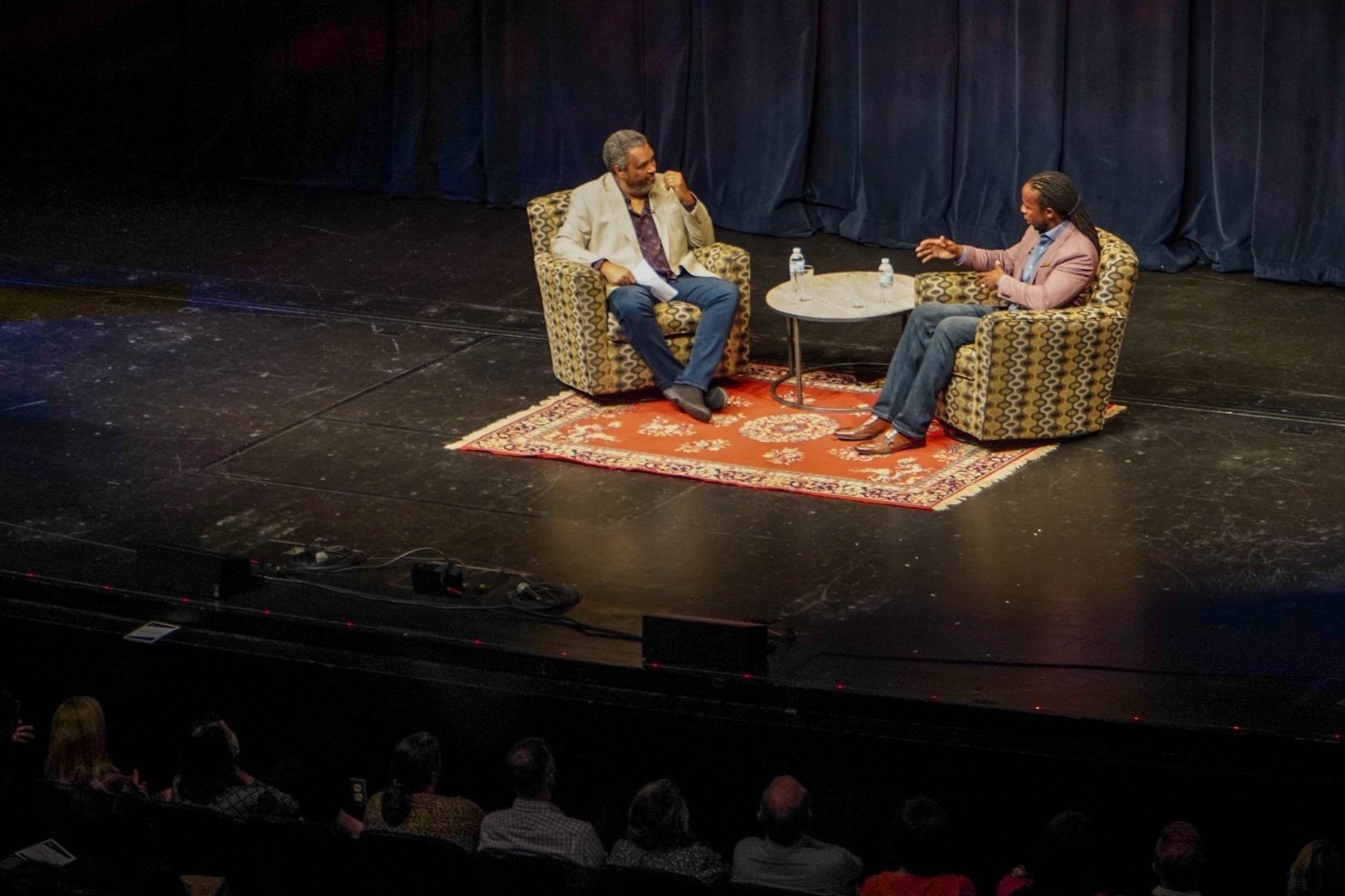SCHOLARSHIP
Dr. Ibram X. Kendi is an award-winning historian and world-renowned scholar. He is Professor of History at Howard University. Dr. Kendi’s scholarship focuses on the history of anti-Black racism—namely racist power, policy, and ideas—and antiracist resistance across time and space. Dr. Kendi is the first scholar to chronicle the entire history of racist ideas from their construction in 15th century Portugal to the present. His scholarship reveals (1) how the structure of racism came to be, how it functions, how it has reproduced itself over time, and its lingering effects; and (2) how human beings can overcome divisive and pacifying racist ideas to organize together, take action against racism, and create an equitable and just world for all. Dr. Kendi’s research has offered critical findings about the history of race, and a number of original definitions of terms, including racist policy, racist idea, racist, and antiracist.
His groundbreaking scholarship on the history of race originated with his narrative history of racist ideas, Stamped from the Beginning (2016), which will be followed by his narrative history of racist power and policy, a book in progress tentatively titled, Bones of Inequity. His influential scholarship on how people challenge racism began with his first book, The Black Campus Movement (2012), continued with his international bestseller, How to Be an Antiracist (2019), as well as with How to Raise an Antiracist (June 2022).
-
Instead of a singular march of racial progress—with backlashes along the way—there are two dueling historical forces of racial progress and racist progress.
“As I carefully studied America’s racial past, I did not see a singular historical force arriving at a postracial America. I did not see a singular historical force becoming more covert and implicit over time. I did not see a singular historical force taking steps forward and backward on race. I saw two distinct historical forces. I saw a dual and dueling history of racial progress and the simultaneous progression of racism. I saw the antiracist force of equality and the racist force of inequality marching forward, progressing in rhetoric, in tactics, in policies.” - Stamped from the Beginning
-
In the 15th century, Portugal’s Prince Henry pioneered the transatlantic human trade of African peoples that reshaped the modern world. Gomes Eanes de Zurara justified Prince Henry’s slave trading by making the diverse group of African peoples into one people, one inferior Black race, worthy of enslavement.
“In recording and celebrating Prince Henry’s life, Zurara was also implicitly obscuring his Grand Master’s monetary decision to exclusively trade in enslaved Africans. In 1453, Zurara finished the inaugural defense of African human-trading, the first European book on Africans in the modern era. The Chronicle of the Discovery and Conquest of Guinea begins the recorded history of anti-Black racist ideas. Zurara’s inaugural racist ideas, in other words, were a product of, not a producer of, Prince Henry’s racist policies concerning African human-trading.” - Stamped from the Beginning
-
Since the days of Gomes Eanes de Zurara, racist power has constructed and reconstructed race. Power and racism are the parents of race. But race lives socially. Meaning, even though race doesn’t exist genetically, the racist ideas of human beings cause them to believe race really does exist. People attach positive and negative qualities to different races, which justify racial inequities and veil racist policy. The solution is not to ignore race (and thereby ignore racism). The solution is to eliminate racism.
“Race is a mirage but one that we do well to see, while never forgetting it is a mirage, never forgetting that it’s the powerful light of racist power that makes the mirage.” - How To Be An Antiracist
-
Producers of racist ideas have largely created and reproduced racist ideas to justify old and new racist policies that have typically benefitted them. As people have consumed these racist ideas, they have become ignorant and hateful.
“Ignorance/hate –> racist ideas –> racist policies: this causal relationship is largely ahistorical. It has actually been the inverse relationship—racist policy led to racist ideas which led to ignorance and hate. Racist policy –> racist ideas –> ignorance/hate: this is the causal relationship driving America’s racial history.” - Stamped from the Beginning
-
Racial group is a more appropriate term of analysis than race to reveal what Kimberlé Crenshaw terms “intersectionality.” Native women and White men are racial groups—not races—and the disparities between these two racial groups are the result of the intersection of racism and sexism, or gender racism. Other intersectional oppressions include ethnic racism, gender racism, disability racism, class racism, and queer racism.
“Like the other identifiable races, Black people are in reality a collection of groups differentiated by gender, class, ethnicity, sexuality, culture, skin color, profession, and nationality—among a series of other identifiers, including biracial people who may or may not identify as Black.” - Stamped from the Beginning
-
No individual or group is essentially or inherently racist or antiracist.
“‘Racist’ and ‘antiracist’ are like peelable name tags that are placed and replaced based on what someone is doing or not doing, supporting or expressing in each moment. These are not permanent tattoos. No one becomes a racist or antiracist. We can only strive to be one or the other in each moment.” - How To Be An Antiracist
-
“Not racist,” like “colorblind” and “race neutral,” are terms developed by racist thinkers to feign neutrality, to deny or veil racism.
“What’s the problem with being ‘not racist’? It is a claim that signifies neutrality: ‘I am not a racist, but neither am I aggressively against racism.’ But there is no neutrality in the racism struggle. The opposite of ‘racist’ isn’t ‘not racist.’ It is ‘antiracist.’ What’s the difference? One endorses either the idea of a racial hierarchy as a racist, or racial equality as an antiracist. One either believes racial inequities are rooted in groups of people, as a racist, or locates the roots of racial inequities in power and policies, as an antiracist.” - How To Be An Antiracist
-
Instead of the simple duality of “not racist” and racist, there is a tripartite division of antiracist and two kinds of racist—segregationist and assimilationist.
“Antiracist ideas are based in the truth that racial groups are equals in all the ways they are different, assimilationist ideas are rooted in the notion that certain racial groups are culturally or behaviorally inferior, and segregationist ideas spring from a belief in genetic racial distinction and fixed hierarchy.” - How To Be An Antiracist
-
White median wealth is about 10 times the Black median wealth in the United States, which is an example of a racial disparity. There are two explanations for this racial disparity: (1) racist ideas; White people have more wealth because they are more financially literate and take care of their money better than Black people; or (2) racist policy; the cumulative impact of measures like redlining that suppressed Black wealth and increased White wealth.
“Time and again, powerful and brilliant people have produced racist ideas in order to justify the racist policies of their era, in order to redirect the blame for their era’s racial disparities away from those policies and onto Black people.” - Stamped from the Beginning
-
Racist policies lead to racial disparities. Civil rights legislation in the 1960s outlawed policies with explicitly stated racist "intent." However, intent can be easily hidden not using racial language in the law or policy. By identifying racist policies by their outcome, racial disparities become a signpost for racist policies. These policies can thus be discovered, measured, and replaced with equitable and just policies.
-
The Black Campus Movement – a social movement powered by hundreds of thousands of Black campus activists and their allies between 1965 and 1972 – was pivotal in creating the new ideal of diversity and equity within higher education.
“Black campus activists succeeded in challenging the academy’s century-old racist ideals. The 1954 Brown v. Board of Education of Topeka decision, which deemed unconstitutional separate but equal public policy, did not do this. Neither did the Civil Rights Act of 1964, which outlawed racist discrimination. The Black Campus Movement forced the rewriting of the racial constitution of higher education, the central contention of this text.” - The Black Campus Movement
-
While many caregivers avoid dialogues on race with their children to protect them, talking to kids about race and racism is actually what’s protective. Children live in societies of widespread racial inequities with messages circulating that certain racial groups have less because they are less. Raising kids to be antiracist protects them from internalizing the dangerous racist messages around them. Raising an antiracist society protects all children from being harmed by racist messages and policies.
"To construct antiracism, to be antiracist, we must admit the times we are being racist. To raise an antiracist, caretakers must first overcome that inner voice of denial. They must acknowledge the gravity of the emergency—our society is dangerously racist—and the gravity of their power—I can still raise a child to be antiracist." - How to Raise an Antiracist




